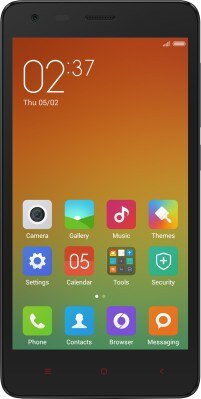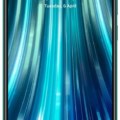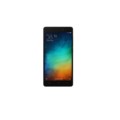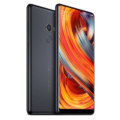- Home
- List of devices
- Xiaomi
- Xiaomi Redmi 2 Prime
Xiaomi Redmi 2 Prime


-
CPU:
-
RAM:
-
Storage:
-
Display:
-
Camera:
-
OS:
With 50% more processing power than its predecessor, Cortex A7, the Cortex-A53 processor on Qualcomm’s Snapdragon 410 guarantees a fluid experience even for the heaviest of users. Its energy efficient Hexagon DSP core maximises work per CPU clock cycle for long lasting battery life and wait for it… 64-bit computing! It’s faster and more powerful than 32-bit processors, and allows for more efficient processing and memory use.
Let your worlds collide with 4G dual SIM, dual standby. You won’t have to manually switch SIM cards around with 4G support on both slots. Intelligent dual SIM features allow you to manage calls and messages easily, according to preferred network and data settings for each card. For instance, Redmi 2 allows you to create custom SIM labels so you don’t get mixed up. It also automatically selects which SIM to use when you call or text someone based on history.
Soak in the view with 1280×720 HD resolution at 123 pixels per cm (PPCM) or 312 PPI. 178° in-plane switching (IPS) technology delivers stunning color consistency from almost any angle. We’ve also designed a fully laminated display which allows pixels to sit close to the glass, so colors pop right off the screen and are less affected by glare. All this is protected with a highly shatter and scratch-resistant AGC Dragontrail glass that is known for being incredibly strong despite being very thin and light.
Take sharp, clear images. The 8MP camera uses backside illumination (BSI) for great low-light performance at night, while infrared sensor protection improves image quality in sunlight. Shoot in HDR, panorama, fisheye, use voice commands, and more. The 2MP front camera records 720p HD video and comes with Beautify, which intelligently guesses age and gender in order to apply 36 smart filters. Selfies look great even without photo editing!
Comfort without compromise. We’ve kept the same 11.9cm (4.7″) display but designed Redmi 2 to be lighter at 133g and thinner at 9.4mm. It also features rounded corners and a textured back that feels great in your grip.
Redmi 2 uses two noise-cancelling silicon microphones that provide better signal-to-noise ratio than traditional ECM microphones, producing sound that remains clear even in the noisiest environments.
Last longer with a 2200mAh lithium-ion polymer battery, which has 10% more capacity compared to Redmi 1S. Also comes with Quick Charge 1.0, which speeds up charging by 20%.
Specs
General
| Announced | 01 August, 2015 |
| Released | 01 August, 2015 |
| Status | Available |
Display
| Display Type <strong>Display Technology => </strong> A number of display technologies and types used in mobile phones => TFT (Thin Film Transistor), IPS (In-Place Switching), OLED (Organic Light Emitting Diode), AMOLED (Active-Matrix Organic Light-Emitting Diode), Super AMOLED (an even advanced version of AMOLED), Resistive Touchscreen (Resistive touchscreens contain two layer of conductive material with a very small gap between them which acts as a resistance), Capacitive Touchsceen (Capacitive touchscreen technology consists of a layer of glass coated with a transparent conductor) | IPS LCD |
| Size | 4.7 |
| Resolution | 720 x 1280 |
| Pixel Density <strong>Pixel Density (PPI)</strong> is refers to the concentration of pixels on a particular display, measured in pixels per inch (ppi). Pixel density is calculated by dividing the diagonal pixel resolution of a display by its diagonal size, higher pixel density better display quality. | 312 ppi |
| Secondary Display | No |
Hardware
| Chipset <strong>Chipset</strong> is a group of integrated circuits designed to perform one or a more dedicated functions, often with real time computing constraints, Popular smartphones are equipped with more advanced embedded chipsets that can do many different tasks depending on their programming. | Qualcomm® Snapdragon™ 410 |
| CPU <strong>CPU</strong> (Central Processing Unit) mostly known as processors, CPU processes instructions in order to carry out certain functions that make your device operate properly. Processors are often described as the brain of computers, smartphones and tablets, Smartphones and tablets rely on processors to carry out their every task, Processors are an incredibly important factor in selecting any type of computing device, including your smartphone. | 1.2GHz Quad Core |
| GPU <strong>GPU</strong> (Graphics Processing Unit) is a single-chip processor designed to rapidly manipulate and alter memory to accelerate the creation of images in a frame buffer intended for output to a display, This includes things such as lighting effects, object transformations, and 3D motion. | Adreno 306 |
| RAM (Memory) <strong>RAM</strong> (Random Access Memory) is a type of computer memory that can be accessed randomly, any byte of memory can be accessed without touching the preceding bytes that allows information to be stored and accessed quickly from random locations. RAM is the most common type of memory found in computer systems, smartphones, tablets and other electronic devices. | 2GB |
| Internal Storage <strong>Internal Storage</strong> is a data storage space (flash memory) mostly used in smartphones, tablets and other electronic devices where operating system, apps, music, photos, videos, files and other user data Is stored. | 16GB |
| Card Slot <strong>Memory Card Slot</strong> is a special slot for inserting a memory card. Memory cards allow you to expand the phone's built-in memory, A memory card (sometimes called a flash memory card or a storage card) is a small storage medium used to store data such as text, pictures, audio, and video, for use on small, portable or remote computing devices such as mobile phones, mp3 players, digital cameras. | No |
| Sensors <strong>Sensors</strong> are electronic components that detects and responds to some type of input from the physical environment. The specific input could be light, heat, motion, moisture, pressure and location, The output is generally a signal that is converted to use in computing systems, a location sensor, such as a GPS receiver is able to detect current location of your electronic device. | Compass, Gravity, Gyroscope, Proximity, Light |
Battery
| Battery Type <strong>Battery Type => </strong> Cell phones run on various kinds of batteries depending on the manufacturer, phone size or shape and features. There are basically four types of cell phone batteries => Lithium Polymer, Lithium Ion, Nickel Metal Hydride and Nickel Cadmium. | Li-Poly (Lithium Polymer) |
| Capacity <strong>Battery Capacity</strong> is a measure (typically in Amp-hr) of the charge stored by the battery, and is determined by the mass of active material contained in the battery. The battery capacity represents the maximum amount of energy that can be extracted from the battery under certain conditions. | 2200 mAh |
| Standby <strong>Standby Time</strong> is the total amount of time that you can leave your is fully charged, turned on and ready to send and receive calls or data transmissions before completely discharging the battery. | removable |
| Fast Charging | Yes |
Camera
| Primary <strong>Camera</strong> is able to capture photographs and usually videos, The most important characteristics of a camera are the resolution (measured in megapixels), lens focus type (fixed or automatic), higher megapixel cameras are known to capture higher quality photos, but not always a good measurement of the photos quality. | 8mp |
| Camera Features |
5-element lens f/2.2 aperture |
| Secondary | 2mp |
| Video | Up to 1080p |
| Flash <strong>Flash Light => </strong> There is commonly two types of flash lights are used in camera mobile phones, LED Flash (LED flash offers lower power consumption with drive circuitry that takes up very little room, LEDs can be strobed faster than any other light source), Xenon Flash (xenon flash produces an extremely intense full-spectrum white light for a very short duration) | Yes |
Design
| Type <strong>Design Type</strong> called form factor refers to a mobile phone's size, shape, and style as well as the layout and position of major components of phone. There are three major form factors seen in mobile phones => bar phones, folding phones and sliding phones. | Bar |
| Dimensions | 134 x 67.2 x 9.4 mm |
| Colors | White, Grey |
Network
| SIM <strong>SIM</strong> (Subscriber Identity Module) is a small card that contains mobile network subscriber's account information. This allows the phone using the card to attach to a mobile network. The SIM card is most commonly associated with GSM and UMTS mobile networks. Moving a SIM card from one phone to another allows a subscriber to switch mobile phones without having to contact their mobile network carrier. SIM cards can also be used by a phone to store limited amounts of data, such as phone numbers and text messages. | Micro SIM |
| Dual SIM | Yes |
| 2G Network | GSM (900/1800 MHz) |
| 3G Network |
WCDMA - Band 1 (2100 MHz) - Band 8 (900 MHz) |
| 4G Network |
FDD-LTE - Band 3 (1800 MHz) TDD-LTE - Band 40 (2300MHz) |
Software
| Operating System <strong>OS => </strong> Every computer system run on a base software called Operating System (OS). Operating System controls all basic operations of the computer (such as smartphone, PDAs, tablet computers and other handheld devices). The Operating System allows the user to install and run third party applications (apps), apps are used to add new functionality to the device. | Android 5.1 Lollipop |
| User Interface <strong>UI</strong> or user interface of a device is the look and feel of the on-screen menu system. How it works, its color scheme, how it responds to button presses, all of these things are part of the user interface. | MIUI 7 |
Connectivity
| Bluetooth <strong>Bluetooth</strong> is a wireless communications technology for exchanging data between mobile phones, headsets, computers and other network devices over short distances without wires, Bluetooth technology was primarily designed to support simple wireless networking of personal consumer devices. | v4.0 |
| Wi-fi <strong>Wi-Fi</strong> is a popular wireless networking technology using radio waves to provide high-speed network connections that allows devices to communicate without cords or cables, Wi-Fi is increasingly becoming the preferred mode of internet connectivity all over the world. | 802.11 b/g/n |
| USB | 2.0 |
| GPS <strong>GPS</strong> The Global Positioning System is a satellite-based radio navigation system, GPS permits users to determine their position, velocity and the time 24 hours a day, in all weather, anywhere in the world, In order to locate your position, your device or GPS receiver must have a clear view of the sky. | Yes |



